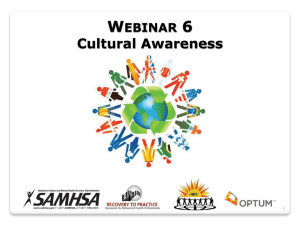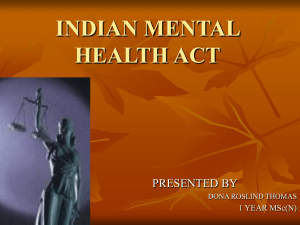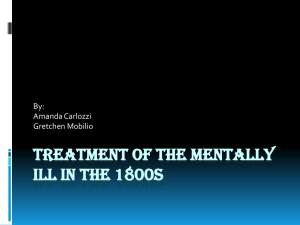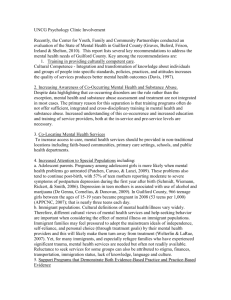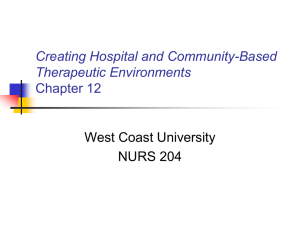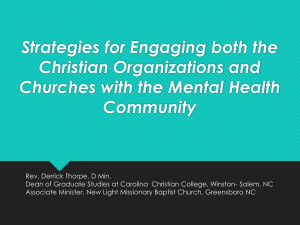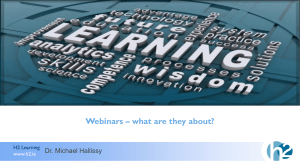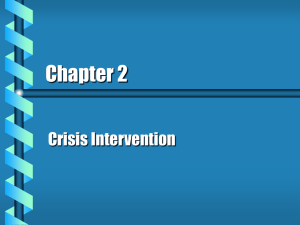Webinar 7
advertisement
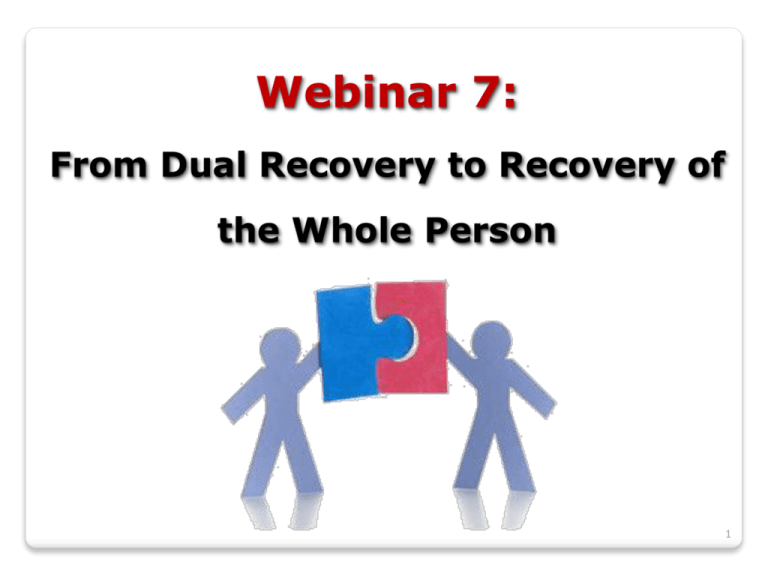
Webinar 7: From Dual Recovery to Recovery of the Whole Person 1 PLEASE NOTE: These webinars will be recorded and be made available on our website for future viewing. As a participant in the webinar, your name, voice and any interactions you have in the Q and A session may be included in the recording.. Thank you for your participation! Welcome to the seventh in a series of webinars for peer supporters drawn from the Recovery to Practice (RTP) project, a SAMHSA-funded project to foster recoveryoriented practice in behavioral health professions. This webinar series is presented by members of the International Association of Peer Supporters (iNAPS) with generous assistance of Optum, without whom this series would not be possible. iNAPS is solely responsible for the content of the webinars. The webinar will begin at noon, Eastern. Thank you for your participation! Patrick Hayes Erik Simkins Region 4 Recovery Support Specialist for the Illinois Dept. of Human Services/Division of Mental Health Wellness Coach and Certified Recovery Support Specialist from the Human Service Center in Peoria, IL Peter Ashenden Director of Consumer Affairs OptumHealth Behavioral Solutions Contact Information T +1 612-632-2963 F +1 877-309-8548 Peter.ashenden@optum.com www.optum.com Objectives For you to be able to: Define co-occurring disorders and reasons why they may co-exist Explain what is meant by integrated treatment Describe three types of recovery capital that can be used in recovery of the whole person 7 What is…. (Canadian Foundation for Drug Policy – Public Health Approach to Drug Control 2005) Risk Factors for Co-occurring Conditions • poverty or unstable income • difficulties at home or school • unemployment or problems at work • isolation or lack of a social network • homeless or lack of decent housing • family problems • family history of mental illness, substance abuse, or concurrent disorders • past or ongoing trauma, abuse, or neglect • discrimination • biological or genetic factors • those who are native or indigenous people • involvement in the criminal justice system ACE Study 17,000 people Adverse childhood experiences Major risk factors for illness, poor quality of life, and death Worst health and social problems are a consequence of ACEs ADVERSE CHILDHOOD EXPERIENCE (ACE) How Many? 8.9 million adults have co-occurring mental and substance use conditions Less than 8% receive treatment for both conditions More than 50% receive no treatment at all Source: SAMHSA 2008/2009 Survey on Drug Use and Health Trauma and substance use 66% of men and women in substance abuse treatment report childhood abuse and neglect 77% of male veterans in substance abuse inpatient units were exposed to severe childhood trauma; 58% had a history of lifetime PTSD 50% of women in substance abuse treatment have a history of rape or incest (Huckshorn, 2012) Co-occurring conditions is an expectation… …not an exception. ~~Ken Minkoff Signs of Substance Use Four “C’s” to look for: Loss of Control Compulsive use Craving Consequence Assumptions about Recovery Recovery may occur whether one views the illness as biological or not. The key is understanding there is hope for the future, rather than understanding there was a cause in the past. ~ William Anthony What’s Strong Recovery of the Whole Person A word about language Triple Stigma Mental disorder Substance use disorder Stereotype / stigma Language is powerful MICA (mentally ill, chemical abuser) MISA (mentally ill, substance abuser) MISU (mentally ill, substance using) CAMI (chemically abusing, mentally ill) SAMI (substance abusing, mentally ill) MICD (mentally ill, chemically dependent) Dual diagnosis or Dually disordered Co-morbid disorders Language Matters Source: Language Matters Brochure – Hogg Foundation Language is powerful Reframe Perceptive Sensitive Shy Exuberant Origins of Addiction - Vincent Felitti, MD. (ACE Researcher) Environmental Factors The whole is greater than the sum of its parts. ~~Aristotle Segregated Systems Mental health and addiction fields have different historical roots and traditions. Two distinct groups of practitioners have different training and approaches. Integration has been difficult because of political, fiscal, structural, and attitudinal influences that have been hard to overcome. Focus on deficits, dysfunction, illness, and treatment has hindered integration. Integrated Treatment Research has consistently shown that for individuals to receive effective care, mental health and addiction services must be integrated. ~~ Davidson & White Stages of Change Stages of Change Physical Emotional Environmental Intellectual Financial Occupational Social Spiritual 28 Stage-wise Treatment Harm Reduction Alcohol Cigarettes Street Drugs Prescription Drugs Harm Reduction Self-Help Resource Search for “HARM REDUCTION” and “ICARUS PROJECT” DUAL RECOVERY http://www.nytimes.com/interactive/science/lives-restoredseries.html#/antonio-lambert Recovery Capital Things we can be grateful for… • Social • Physical • Human SMALL GROUPS Finding Hidden Treasure Steps: 1. Three types (social, physical, human) 2. Give one example of recovery capital (in each category) 3. Four rounds, list examples 4. Share ‘aha’ moments in group 5. Share with large group 36 ROLE PLAY Summary Are you able to: Define co-occurring disorders and reasons why they may co-exist? Explain what is meant by integrated treatment? Describe three types of recovery capital that can be used in recovery of the whole person? 37 ? ? ? Questions…. To unmute your line, press *6. To mute your line again, press *6 Overall RTP Project www.samhsa.gov/recoverytopractice Resource Library www.dsgonline.com/rtp/resources.html Peer Supporter Discipline www.inaops.org Wounded Healer Video http://www.youtube.com/watch?v=orxEawi9qro E-mail: webinars@naops.org Special thanks to Chacku Mathai, for his generous help in developing this module Recovery Relationships December 2, 2013 Go to our website: www.naops.org for up-to-date information
